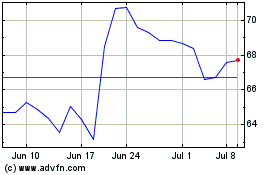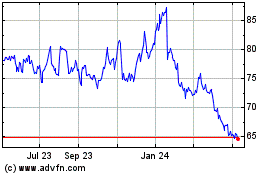China Eases Path for Foreign Drugmakers' Hepatitis C Treatments
April 22 2016 - 6:44AM
Dow Jones News
SHANGHAI-- China will grant four global drug companies
priority-review status to launch groundbreaking new hepatitis C
treatments in China, a rare move to open the lucrative market to
foreign players.
China's Food and Drug Administration expedites domestic drug
applications to encourage innovation. But its lengthy drug-approval
process for foreign companies means none of the direct-acting
antiviral agents that have been shown to cure more than 90% of
hepatitis C patients within a few months have been approved in
China, which has among the highest rates of the disease in the
world with an estimated 10 million people infected.
Chinese patients tired of old-generation therapies such as
interferon injections have increasingly traveled overseas to access
the new therapies.
Hepatitis C treatments from Gilead Sciences Inc., AbbVie Inc.,
Bristol-Myers Squibb Co and Janssen Pharmaceuticals Inc.'s Chinese
joint venture Xian Janssen are now expected to enter the world's
second-largest pharmaceuticals market in a shorter time, according
to an announcement from the Center for Drug Evaluation this week.
Two domestic companies and a Taiwanese company also will get
priority review-status for hepatitis C drugs.
Industry experts say priority-review status doesn't guarantee
approval but welcomed the move.
"It shows that the CFDA is serious about prioritizing important
new innovative medicines that address real unmet medical need or
improve substantially on what's currently available, whether they
originate in domestic or [global] pharma companies," said Laura
Nelson Carney, senior research analyst at Bernstein Research.
In a rare response to a request to comment on its strategy, the
CFDA said it welcomes innovative drugs to enter China, "the
earlier, the better." But it stressed that speed shouldn't trump
quality and that the review process would follow strict
standards.
Spokespeople for Gilead Sciences, AbbVie, Xian Janssen and
Bristol-Myers Squibb all welcomed the decision and said they were
looking forward to bringing new hepatitis C treatments to people in
China.
It is unclear how much sooner the foreign drugs will reach the
Chinese patients. The drug regulator says it will start the review
process within 10 days for drugs that have been prioritized. On
average, standard applications to start trials take about 17 months
while applications to market drugs take a further 20 months,
according to the analysis by IMS Health.
Since a policy was enacted in February to prioritize innovative
treatments for a number of diseases, including viral hepatitis,
AIDS and tuberculosis, several domestic companies have secured
priority status. The latest batch of companies was the first
including foreign ones.
The treatments must show significant advantage over drugs
already on the market.
The policy also encourages foreign companies to manufacture
drugs in China, saying companies will qualify for priority
treatment if they submit applications for approvals in China
simultaneously with U.S. and European Union approvals and use the
same production standards as in those markets.
Global drugmakers have long complained that the delay of drug
approvals in China has squeezed their profits. The sales of
off-patent branded drugs are still the main source of revenue for
global companies in China, partly because they are of better
quality than domestic generic drugs and partly because the long
approval process means companies only have a short window to profit
from patented brand drugs before patents expire.
The Chinese drug regulator has pledged to lift the quality of
domestic generics as part of an effort to bring down drug prices
and bring them more in line with branded drugs from foreign
companies.
Some global drugmakers have shifted focus away from mature drugs
in China toward innovative ones. In February, British
pharmaceutical giant AstraZeneca PLC sold the regional commercial
rights of two best-selling heart drugs, Plendil and Imdur, to China
Medical System Holdings Ltd. for $310 million and $190 million
respectively. The company also disclosed that it is developing
three innovative products in China via local manufacturing.
Fanfan Wang
(END) Dow Jones Newswires
April 22, 2016 06:29 ET (10:29 GMT)
Copyright (c) 2016 Dow Jones & Company, Inc.
Gilead Sciences (NASDAQ:GILD)
Historical Stock Chart
From Mar 2024 to Apr 2024

Gilead Sciences (NASDAQ:GILD)
Historical Stock Chart
From Apr 2023 to Apr 2024
